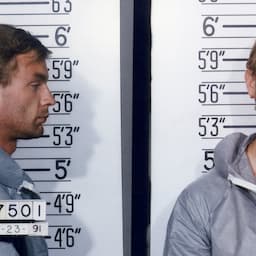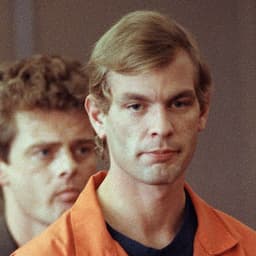Two people close to the victims recount encountering the murderer in ‘Conversations With a Killer: The Jeffrey Dahmer Tapes.’
Thirty years after Jeffrey Dahmer was arrested in 1991 and charged with killing 17 men and teenage boys over a 13-year span, two of the victims’ friends are speaking out in the Netflix docuseries, Conversations With a Killer: The Jeffrey Dahmer Tapes. Both Michael Ross and Jeff Connor detail their encounters with the serial killer, remember the last time they saw their friends alive and explain why it’s important to “humanize the individuals who lost their lives.”
“Recognizing that each one of those young men had a mother, a father, had sisters and brothers that loved them and still miss them,” says Ross, who was close with several of the men killed by Dahmer, including Tony Sears, Tony Hughes, Ernest Miller and Eddie Smith.
“I knew Jeffrey Dahmer and several of his victims,” Ross reveals, before going on to speak about Sears, who was also a friend of Connor’s. “Tony Sears was about 23 or 24. Tony Sears was a model. He was very attractive and he was always immaculately dressed. Had the most beautiful hair. Back in the day, we called them Jheri curls,” Ross says.
“He was always upbeat, always energetic. He was always out for an adventure, always wanted to do something new,” Connor says. “You just never knew where your night was gonna go, but you just knew you were going to have a good time.”
It was Connor who was with Sears the last night anyone saw him alive, and he recalls meeting Dahmer, although he didn’t know who he was at the time. “When the end of the evening came, we met up back right on the corner that we always did. And he had this other guy with him,” he says. “He wasn’t overly good-looking. I wouldn’t say he was ugly. He had just blond hair. He was wearing glasses. We just sat on the corner and talked a bit about our evenings, who we bumped into, where we went, that sort of thing.”
Not wanting the night to end, the three ended up going to breakfast before Connor dropped them off at Dahmer’s house, which would later turn out to be his grandmother’s home where he killed some of his earliest victims. “Then they hopped out. I said goodbye to Tony and reminded him that if he needed a ride to call me before such and such a time. They just walked up the street, and I drove off,” he says.
It wasn’t until a few days later, when Sears’ family called Connor that he knew he was missing. But as Dahmer’s murders continued, more and more people, especially among the gay Black community, started to disappear. “It was often you walk in a bar and people say, ‘Child, another one missing,’ And you say, ‘Who’s missing now?’” Ross says, recalling that “I was seeing Eddie Smith all the time. And all of a sudden, he was gone.”
“Ernest Miller, another young man. Ernest had a good soul. He was very creative,” Ross continues. “So, of course, when Ernest came up missing that was talk in the bars too.”
Similarly to Connor, Ross was also one of the last people to see Hughes alive -- with Dahmer. “Tony knew Jeff for a long time. And Tony and Jeff had had relations. Tony told me so,” Ross says. “It was Memorial Day weekend of 1991. Tony Hughes and I were together in a bar called The Phoenix. We were sitting at the bar having cocktails and Jeff came in the back door. Jeffrey Dahmer. When Jeff walked in, Tony got up from the bar and approached him. Tony left me and went to follow Jeff on the dance floor.”
He adds, “That was the last time I saw Tony Hughes.”
While Ross and Connor are featured in the docuseries, none of the victims’ relatives agreed to appear on camera, with director Joe Berlinger revealing to ET that “most either did not respond or declined, and I can understand why.” However, following the release of Dahmer - Monster: The Jeffrey Dahmer Story, many of them lashed out at Ryan Murphy’s scripted drama for “retraumatizing” their experiences and for not reaching out about the project.
“You know, whenever we tell these stories, I feel like we obviously have to tell them responsibly and to honor the victims,” Berlinger says, acknowledging the backlash surrounding the scripted series. He goes on to explain that Conversations With a Killer “does that by looking at the case through a 2022 lens to kind of give it some social justice reason for being told.”
And both Ross and Connor speak to that, explaining how homophobia and racism allowed Dahmer to go unnoticed for such a long time. “I was in the bar often. Nobody asked me about anybody. I didn’t have any police officer, any detective come up to me and say, ‘What do you know about this person or that person?’ This wasn’t a couple of months or a couple of weeks, this went on for years,” Ross says.
He adds, “If the victims had been white and straight, the search would have been more in-depth, more specific.”
When it comes to the police, Connor says “at that time, the relationship between the gay community and the police was not the greatest at all,” before describing how they would show up “in full uniform, guns, hats, badges” at the gay bars, where they were hoping he would identify Dahmer, who Connor only knew of as “this blond, mystery person.”
“I actually had some of the bar owners tell me, ‘You really don’t need to come back here,’ that type of thing,” he recalls.
And in the instance surrounding the investigation into Sears' whereabouts, Connor became their prime suspect. “In the beginning, I was the prime suspect for the simple reason that I was the last person to see Tony alive,” he says. “Tony’s family would ask me things like, ‘Are you giving us all the details? Does this other person really exist, or were you just with Tony?’ It was questions like that that started to take a turn with the family. I also had a lot of friends that I had for quite some time that started thinking the same thing. That, you know, maybe I had done something to Tony.”
After the experience left a bad taste in his mouth, Connor decided to leave town. “At some point through all that, I decided that I had to kind of just get a fresh start. I basically left my life in Milwaukee behind and moved out of the city,” he says, before later adding, “I really cared for Tony. Tony was a great guy. You know, I figured he and I were gonna be friends for quite some time, and, I’m sorry, there’s a lot of what-ifs. Just the fact that some of my actions that I did that evening, I helped this happen to Tony.”
He says, “You know, I wish I could take it all back and make the evening end in a different way.”
The three-part documentary ends with both of them reflecting on the lives lost and what could have been. “It saddens me every time I think about any of those gentlemen. Because like everybody else during that time, they were trying to find themselves. They weren’t expecting to get killed,” Ross says.
“There’s always gonna be that pain, that remembrance of what happened. We’re always gonna do the what-ifs. You know, where would they be now? What kind of life would they have had? You’re always gonna miss that person,” Connor says.
“They were just trying to do what we’re all trying to do: Survive. Live and enjoy the life they’d been given. They had a life that they loved. I think it’s important to tell their story. Nobody deserves to die like that,” Ross concludes.
Conversations With a Killer: The Jeffrey Dahmer Tapes is now streaming on Netflix.
RELATED CONTENT:
TV




